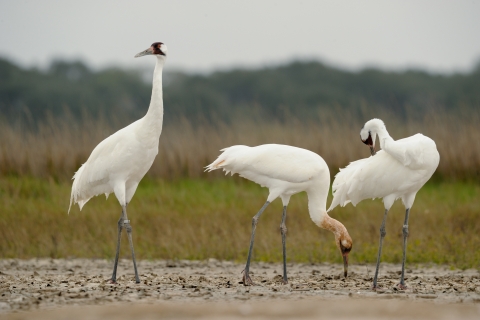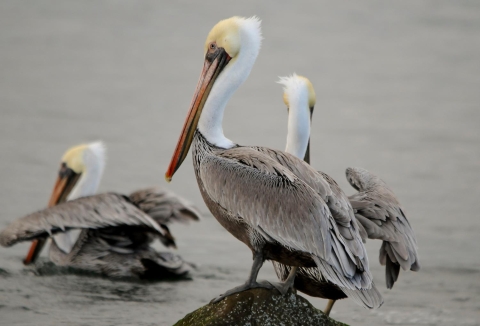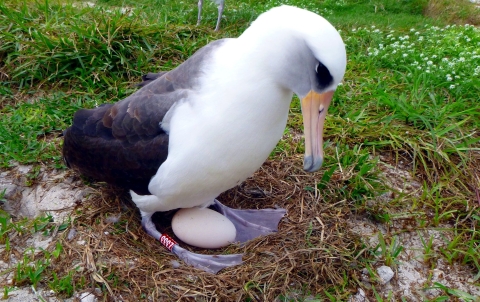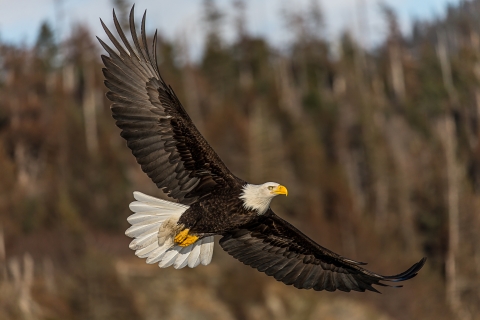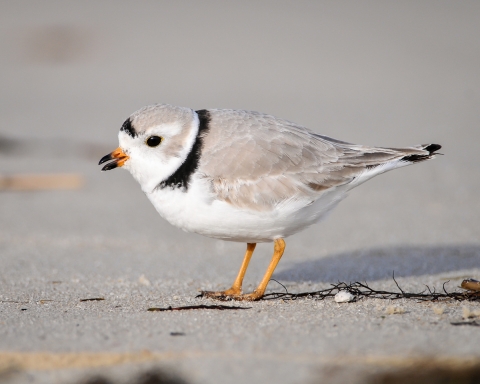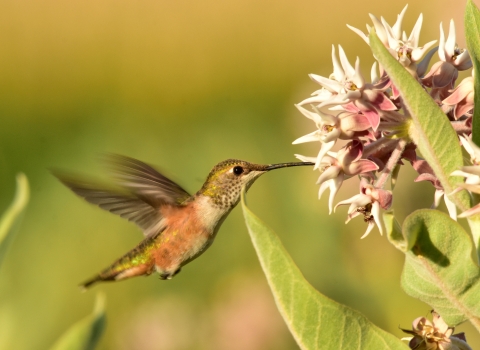Like birds? Thank a national wildlife refuge national wildlife refuge
A national wildlife refuge is typically a contiguous area of land and water managed by the U.S. Fish and Wildlife Service for the conservation and, where appropriate, restoration of fish, wildlife and plant resources and their habitats for the benefit of present and future generations of Americans.
Learn more about national wildlife refuge . Many bird species owe their existence at least in part to national wildlife refuges and their conservation efforts. Here are some examples.
Whooping crane — Aransas National Wildlife Refuge, Texas
In 1941 – four years after Aransas National Wildlife Refuge was established to conserve migratory waterfowl and other birds – the world’s last 16 whooping cranes were found wintering on the Texas refuge. The refuge improved and expanded crane habitat and partnered in crane research.
Captive breeding of the Eastern migratory flock of whooping cranes took place at Patuxent Research Refuge in Maryland from 1967 to 2016. Other conservation groups have since taken over.
Today, the North American count of whooping cranes (captive plus wild populations) tops 800. The last wild flock of whooping cranes migrates 2,500 miles from breeding grounds in Canada’s Wood Buffalo National Park to wintering grounds on the Texas coast. Aransas Refuge tracks and monitors the endangered birds and manages habitat to boost food resources and provide fresh water during drought conditions.
California condor — Hopper Mountain National Wildlife Refuge and Bitter Creek National Wildlife Refuge, California
The California condor, a New World vulture and the largest North American land bird, was nearly killed off by shooting, egg collection and poisoning. Only 30 or so birds remained when Hopper Mountain National Wildlife Refuge was established in 1974 to protect condor habitat and buffer the adjacent Sespe Condor Sanctuary. Bitter Creek National Wildlife Refuge joined the effort in 1985.
From the two refuges, staff and conservation partners release captive-bred condors into the wild. They also monitor wild nests and trap condors to assess general health, replace transmitters and sample blood for lead levels. Lead poisoning causes half of all condor deaths with a determined cause, and prevents full recovery of the species. Condors ingest spent lead ammunition when they feed on carrion that has been shot.
Today, refuge staff and partners monitor a flock of 100 free-flying condors that range across 15,000 square miles. More than 300 condors fly free in the wild in California, Arizona, Utah and Mexico. The world population of condors, including 180 in captivity, exceeds 500.
Story: “The Condor Nearly Went Extinct. Now, a Recovery Program’s 1,000th Chick Has Hatched”(Smithsonian)
Brown pelican — Pelican Island National Wildlife Refuge, Florida
This distinctive seabird with the big neck pouch has a central place in the history of the National Wildlife Refuge System. It was to save brown pelicans from slaughter by plume hunters that President Theodore Roosevelt established Pelican Island as the country’s first national wildlife refuge in 1903. The bird — also hit hard by DDT poisoning — was classified as endangered in the 1970s. Habitat protection and the 1972 ban on DDT helped brown pelicans make a strong recovery. In 2009 the species was removed from the list of threatened and endangered species throughout its range. The global population of brown pelicans now exceeds 350,000.
Laysan Albatross — Midway Atoll National Wildlife Refuge, Pacific
More than 70 percent of the world’s nesting population of Laysan albatross resides on Midway Atoll. The oldest known bird in the wild is a Laysan albatross (shown above) known to the world as Wisdom. Wisdom has reared as many as 40 chicks in her lifetime. At more than 70 years of age, Wisdom continues to lay eggs and raise chicks. She has become an international symbol of hope for species dependent upon the health of the ocean. She continues to nest and rear chicks along with her mate.
Bald eagle — Elizabeth Hartwell Mason Neck National Wildlife Refuge, Virginia
The North American bald eagle is one of the best-known conservation success stories. Fifty years ago, the bird that is our nation’s symbol was in danger of extinction throughout most of its range. Habitat destruction, illegal shooting and DDT contamination all played a part.
In 1969, the U.S. Fish and Wildlife Service established Mason Neck National Wildlife Refuge to conserve the eagle’s nesting, feeding and roosting habitats along the Potomac River. The banning of DDT in 1972 and passage of the Endangered Species Act in 1973 helped eagles recover. The bald eagle was removed from the federal list of threatened and endangered species in 2007.
Story: "Eagles Across America"
Piping plover — Parker River National Wildlife Refuge, Massachusetts
The refuge was established in 1941 to provide feeding, resting, and nesting habitat for migratory birds. It provides critical habitat for the federally threatened piping plover, a small shorebird whose numbers have dropped because of habitat loss and disturbance.
Plovers arrive to breed and nest on the refuge beach beginning in late March. To minimize human-caused disturbance during this critical period, the refuge restricts public access to the refuge beach in spring. Refuge staff also institute predator controls as needed. Breeding success is closely monitored by refuge biologists throughout the spring and summer months.
Trumpeter swan — Red Rock Lakes National Wildlife Refuge, Montana
In 1935 trumpeter swans were on the brink of extinction, with only 70 birds left, when Red Rock Lakes National Wildlife Refuge was established to protect their last-known stronghold. Today, hundreds of these graceful birds live at the refuge year-round. In summer, the great white birds are easy to spot on their nests, which they build on the water atop muskrat houses or uprooted marsh plants. In winter, they are joined by thousands more trumpeters that fly down to the area from Canada.
Stories
“Wildlife Refuges: Where the Birds Are”
“Seven Great National Wildlife Refuges Everyone Should Visit” (Audubon)


